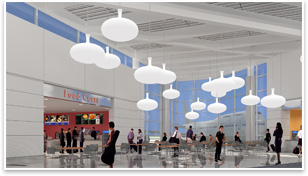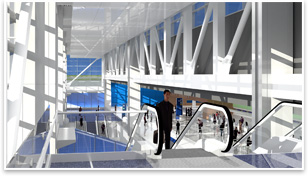
| Now Arriving at the North Terminal: Delivery on Budget and in Style Project delayed three years, revamped, expanded on same budget
How do you … deliver a high performance airport terminal on a tight budget?
“The terminal was authorized by a consortium of airlines in conjunction with the airport prior to 9/11 as a renovation of an existing terminal,” says Bill Hartman, managing director of Gensler Detroit and design principal for the project. “The events of 9/11 led to the postponement of the project, and when the project came back to life it of course carried many more responsibilities and required a different configuration than had been predicted.” The most significant change was that the re-envisioned terminal was no longer a renovation to an existing terminal, but new construction. Among the changes required of the new project were demolition of the existing terminal and an adjacent hotel, additional square footage to support security, contained customs and border protection facilities, and a “bomb room” for explosives detection in checked baggage. On top of that, the budget was not increased to accommodate the new program.
How did they do it? “It’s going to sound corny but it’s true,” jokes Hartman. “It was a very close team effort between the project director for the airport, the construction manager, and myself as the design team lead.” The project team met weekly and had three different entities providing cost estimates during preconstruction phases to be accurate as possible. Hartman says that to meet the strict budget, the team had to change paradigms of the past and accept simpler construction methods and materials. One example of their cost-cutting ingenuity was using color as an orientation device. “Just because it’s low budget doesn’t mean it can’t be well designed, and so we used strategies that didn’t add extra cost, particularly with the movement of passengers.” The team used a bright blue color for the major architectural landmarks in the building—from the jet bridges to the baggage claim—so that the passenger progression was both logical and inherent. “We did that without having to be lavish with our materials, instead being simple with our color so the ‘color is free’ dictum was one of the design principles employed.”
“We’re fond of saying those blue jet bridges are really green, because it’s through jet bridges that we deliver preconditioned air, power, and potable water to the aircraft when they’re at the gate,” enthuses Hartman. The terminal’s linear configuration allows the movement of aircraft to be very simple and efficient, so the aircraft can be quickly turned around at the gate, which is more efficient for the airlines’ flight schedule and requires less fuel and lowers emissions for the airplanes. For its efforts, the Wayne County Airport Authority received a Voluntary Airport Low Emission (VALE) grant from the federal government. “The constraints of the low cost, relatively fast schedule, tight sites, multiple airline tenants is the future,” believes Hartman. “The days of old where many of the airport terminals were able to be very costly and very exuberant in their architectural design has passed as the cost of those facilities is passed along to airlines. Airlines can’t support that sort of facilities burden on their bottom line, and so terminals like Detroit … are some of the first after 9/11 to digest new security concerns with an economic environment for the airlines that is much leaner. The 'less is more’ mantra probably begins to make sense in terminal design, and I say that without compromising the support for passenger and aircraft movement. The efficiencies on the part of the airline and clarity and simple circulation on the part of the passengers need to go hand in hand.” |
||
Copyright 2008 The American Institute of Architects. All rights reserved. Home Page |
||
news headlines
practice
business
design
recent related
› Indianapolis Constructs Greenfield Airport
› Business Travel Made Easy
› Gensler to Design JetBlue Terminal for JFK
Renderings courtesy Gensler.
1. North Terminal at Detroit Metropolitan Airport (DTW), by Gensler, is one of the few new terminals to be completed since 9/11.
2. The facility’s food court continues the theme of simplicity.
3. “Less is more” is the new mantra for airline facility design.
4. One example of their cost-cutting ingenuity was using color as an orientation device.
Knowledge Community
See what the Technology in Architectural Practice (TAP) knowledge community is up to.
Find out what’s happening with the Committee on the Environment (COTE).
Do You Know SOLOSO?
The AIA’s resource knowledge base can provide you with information on subjects as varied as how to grow and manage your firm to green building practices. See what SOLOSO has to offer you.

 Summary:
Summary:


